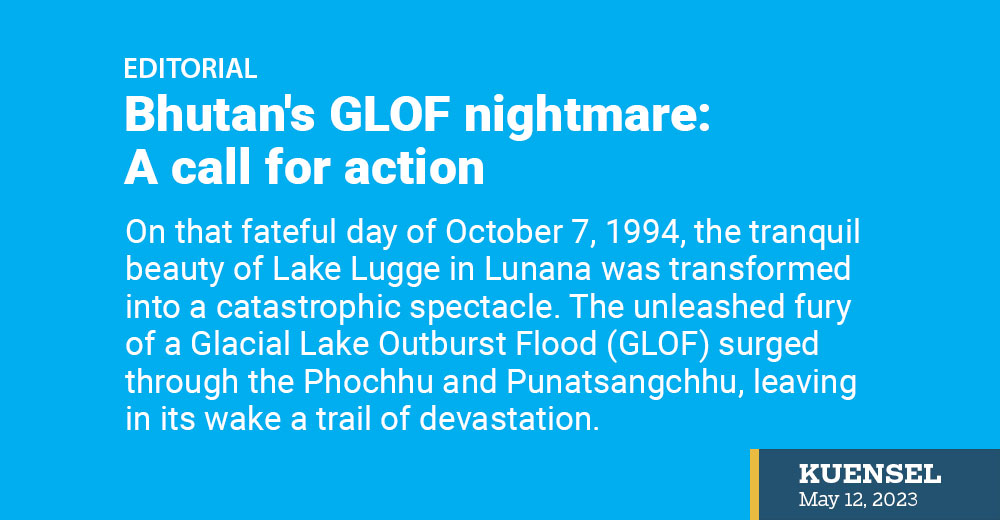On that fateful day of October 7, 1994, the tranquil beauty of Lake Lugge in Lunana was transformed into a catastrophic spectacle. The unleashed fury of a Glacial Lake Outburst Flood (GLOF) surged through the Phochhu and Punatsangchhu, leaving in its wake a trail of devastation. Lives were lost, properties were obliterated, and the land lay scarred. It was a horrifying reminder of the immense power held by these volatile bodies of water.
Fast forward to the present, and Bhutan stands at the precipice of an impending GLOF disaster. Nestled amidst the mighty Himalayas, our nation and its surrounding regions have been identified as high-risk areas for such calamities. A recent study has cast a shadow of alarm, revealing the looming threat posed by four lakes: Bechung, Raphstreng, Thorthormi, and Lugge Tsho. These glacial lakes are ticking time bombs, capable of unleashing GLOFs with staggering outflow volumes ranging between 6×10^5 and 3×10^8 m^3.
The potential consequences are chilling. Over 16,000 lives hang in the balance, as do 2,721 buildings, 6,157 precious livestock, and 11.8km^2 of fertile agricultural land. The arteries that connect our communities, the roads stretching 101.4km, along with 71 vital bridges, teeter on the edge of destruction. Even our prized hydropower projects, PHP-I and PHP-II, lie vulnerable, with their very existence threatened up to 150km downstream from these ticking glacial time bombs.
The implications are clear, and the call for immediate action cannot be ignored. We must awaken to the gravity of the situation and take charge of our destiny. The preservation of lives and the safeguarding of our nation’s future lie in the hands of our leaders, our scientists, and every citizen of this great land.
Continuous monitoring of glacial lakes in the Lunana region and throughout Bhutan is an imperative that cannot be overstated. We must be ever-vigilant, ever-ready to detect the slightest tremor, the subtlest signs of impending catastrophe. It is time to invest in state-of-the-art early-warning systems, ensuring that every citizen is swiftly alerted when danger approaches. We owe it to ourselves and future generations to be prepared, to be proactive, and to be united in the face of this shared peril.
A robust GLOF risk-reduction strategy must be swiftly devised and executed. We must harness the power of engineering measures, building structures that can withstand the force of nature’s fury. We must zone our land wisely, effectively managing and mitigating risks to vulnerable areas. Time is of the essence, and every delay carries with it the weight of potential tragedy.
The hour is late, but not too late. By acting decisively, by embracing a collective resolve, we can fortify our defences against the GLOF nightmare that looms. Together, we shall defy the wrath of nature and ensure the safety and prosperity of Bhutan for generations to come. Let this be our rallying cry for action, our clarion call for a resilient and secure future.


